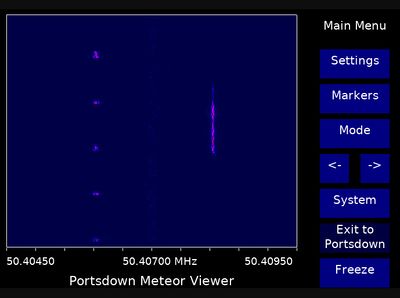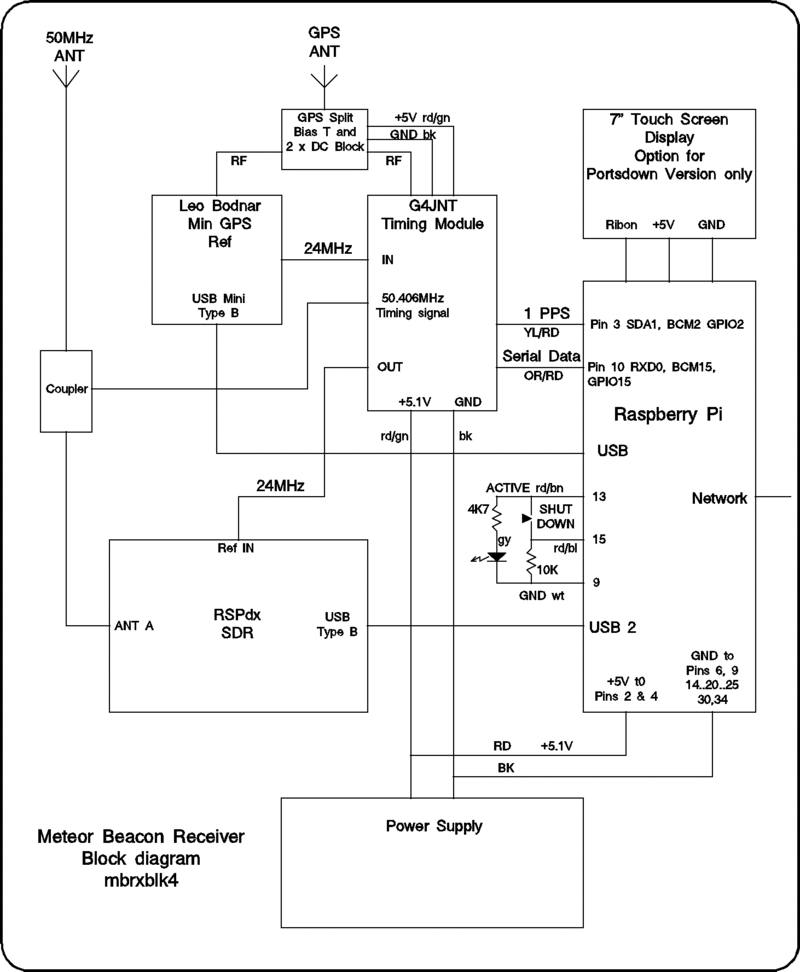Portsdown MeteorView
The Portsdown Meteor Viewer uses an SDRplay RSPdx and displays 10 kHz of spectrum in a waterfall. The RSPdx needs to be connected to the Portsdown 4 USB2 (black, not blue) socket. Other models of the SDRplay RSP family of SDRs may work.
Receiving Meteor Reflections from GB3MBA
This guidance is written specifically to help those who are using the Portsdown MeteorViewer capability. There is lots more information available on the GB3MBA website https://ukmeteorbeacon.org/Home, and even more will be provided as the project progresses.
The SDRplay RSPdx is particularly suited to receiving reflections of GB3MBA from meteors, because it includes a preamp for 50 MHz which (in the specific driver used by Portsdown) is enabled at frequencies above 50.0 MHz. The preamp is sensitive enough to receive local noise, and the positioning of the aerial needs to be carefully considered to maximise the reception of reflections whilst minimising local noise pickup.
As the most common altitude for meteor reflections is about 100 km, and the GB3MBA beacon points vertically upwards, aerials should be aimed at that volume in the sky for the strongest echoes. This table lists the optimum elevation angle depending on your distance from the beacon (which is near Mansfield at 53d 06m 51s N 1d 13m 20s W IO93JC).
| Distance | Elevation |
|---|---|
| 100 km | 45 degrees |
| 150 km | 34 degrees |
| 200 km | 26 degrees |
| 250 km | 21 degrees |
| 300 km | 18 degrees |
| 350 km | 16 degrees |
| 400 km | 14 degrees |
The Moxon design of aerial has proved to be particularly successful; an alternative is a 3 element or more yagi.
Once installed, the background noise level should be checked by noting the level of the backround noise in spectrum view with a 50 ohm load connected to the receiver and then connecting the aerial. Background noise increases of less than 10 dB are good; 5 dB would be excellent. Noise increases of over 10 dB are less than satisfactory and a compromise on aerial pointing and siting may need to be made.
Once the installation is complete switch to waterfall view. By default the screen is centered on 50.4075 MHz, and meteor echoes should appear half a division to the right of centre as blips, blips with trails or just trails. At sites less than 250 km from the beacon, aircraft reflections should also be seen regularly.
MeteorView Settings
The default setting for MeteorView is to have a 10 kHz span width as this is the only span width that works when uploading to the central server. However, there are a range of settings for local mode.
Span widths of 5 kHz and 2.5 kHz are also available. The image above shows 5 kHz span width with 1 second timing pulses (hardware generated in the official beacon network receivers) at 50.406 MHz and a meteor reflection at 50.408 MHz.
The other waterfall configuration settings (accessed from the Waterfall Config menu) are more complex.
"Set Wfall Base Level" sets the signal level (in the range 0 to - 80 dB) where the waterfall displays black. "Set Wfall Range" adds to the base level and sets the muber of dBs above the base level that displays white. These should be set so that all the signals to be displayed on the waterfall come within the range. A colour scale is displayed alongside the classic spectrum view to make this adjustment easier.
"Set WFall Overlap" adjusts the time between each fft sample being analysed and displayed as a new waterfall line. In effect, this sets the speed of the waterfall. The acceptable figues are 1, which gives a 40 second long waterfall, 2 (20 seconds), 4 (10 seconds) and 8 (5 seconds). The default is 4, but it is sometimes easier to see meteors if this is set to 2 or 1 to give a slower waterfall.
"Set Wfall Fraction" allows a smaller time segment of the SDR output to be analysed. This setting has not proved to be effective and should be set to 1. On initial build, the default is 4.
"Set Wfall Timespan" on the "More Wfall Config" Menu should always be set to 0.
None of these settings have any effect when the software is set to stream to the central server.
Streaming Data to a Central Server
By default the Meteor Viewer displays the waterfall locally; however, it can also stream the IQ data to a central server for display with other streams as seen here: GB3MBA Server.
In this mode, MeteorView does not require a touchscreen display and can run totally headless.
The streaming settings are accessed from System", "Streaming Menu". The "Server IP" and "Server Port" are set with the correct default values and should not be changed.
The "Client Number" determines which panel on the 6-panel web display at http://95.154.252.125:7682/ the stream is displayed on. Client numbers 3 and 5 should be used for ad hoc testing. Permanent assignemnt of client numbers should be discussed with G4NNS or G8GKQ. Once the client number has been correctly set, touch the "Local Display" button and the streaming should commence. You should see the waterfall appear on the web page within a few seconds.
The RF and IF gains for the stream are set from the "Settings", "Gain" menu. The "Streaming RF Gain" and "Streaming IF Gain" should be set with reference to the web page. AGC should be off.
It is quite normal for meteor "pings" to be only visible on one stream, but a number are visible on multiple streams. This is the sort of data that will be analysed in later stages of the project.
Timing Reference
To enable future offline analysis of meteor echoes from disparate receivers, a 1 pps tining reference is coupled into the aerial feed. The original units were designed by And G4JNT and he has described them here. File:GB3MBA_Timing_Module.pdf
The block diagram of a complete receiver is shown here:
A re-design of the timing board is underway to make the interconnection of units simpler.
Building an SD Card for Unattended MeteorView Streaming
First, disconnect any RSPdx during the build. Using a Raspberry Pi 4 with no screen connected, build a new Portsdown 4 SD Card using the instructions here: Portsdown 4 Build Instructions
If building a card using a Portsdown system with a touchscreen, follow the normal build instructions, but then select "M3" and "Web Control Disabled" which should change to "Web Control Enabled", then select "Exit" and follow the instructions below. Again, do not connect the RSPdx during the build.
Once the build has finished and the Raspberry Pi has rebooted, connect the SDRPlay RSPdx to the USB2 socket. Then:
- Open a web browser and point it at the Raspberry Pi's IP address. The address line should look something like this: http://192.168.2.214. Alternatively, if there are no other Raspberry Pis on the network, you can simply enter http://raspberrypi .
- You should see a webpage with 2 buttons. Click the "Touchscreen" button.
- If a screen comes up asking about a LimeSDR, click anywhere to clear the message. Menu 1 should be displayed.
- Click M3 to get to Menu 3.
- Click on System Config to get to the System Configuration Menu.
- Click on the "SD Button Disabled" button to change it to "SD Button Enabled".
- Click on Start-up App. The Start-up Application Menu should be displayed.
- Click on "Boot to MeteorViewer", which should turn green.
- Click Exit to get to Menu 1.
- Click M2 to get to Menu 2.
- Click Reboot to check that system restarts in the correct mode.
- On restart, (after waiting for the Leo Bodnar GPS to stabilise) the MeteorViewer display should show a waterfall in "local" mode.
- Click "System" and then "Streaming Menu".
- Click "Set Client Number". A keyboard will appear.
- Using the mouse and on-screen keyboard, delete the existing Client Number and enter the desired Client Number. Press Enter.
- Then click "Local Display". The application should restart in "remote display" mode and you should see the waterfall on the GB3MBA web Server Client page.
- The gain can be adjusted using the "Remote RF Gain" and "Remote IF Gain" buttons on the "Settings", "Gain" menu.
- The centre frequency can be adjusted using the "Set Frequency" button on the "Settings" menu.

